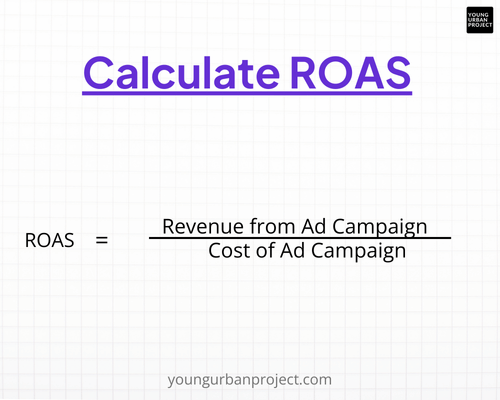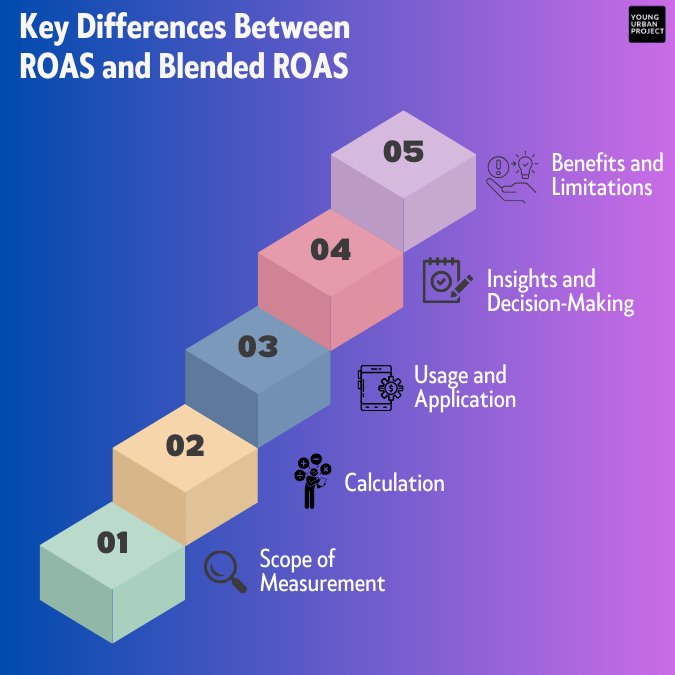Measuring the success of advertising spending in digital marketing is necessary for driving business growth. Return on Ad Spend (ROAS) is a key metric that provides valuable insights into the effectiveness of your advertising efforts.
But is it the best metric to measure campaign health? Or is there something else that might be more effective?
Enter: Blended ROAS.
By calculating ROAS and Blended ROAS, businesses can determine how much revenue is generated for every dollar spent on ads, offering a clear view of their ad campaign’s profitability.
In this blog post, we will understand the significance of ROAS, explaining its role in optimizing ad spend, evaluating performance, and making informed marketing decisions. We will also understand what are the gaps that Blended ROAS fills for a performance marketer.
Table of Contents
What is ROAS?
Return on Ad Spend (ROAS) is a metric that measures the revenue generated for every dollar spent on advertising. It helps marketers understand the effectiveness of their ad campaigns by quantifying the return they get on their advertising investments.
How to Calculate ROAS

Importance of ROAS
Return on Ad Spend (ROAS) is more than just a metric; it is a crucial tool for marketers and business owners to understand the effectiveness of their advertising efforts. Here’s why ROAS is so important:
1. Optimization of Ad Spend
ROAS provides insight into which advertising campaigns are delivering the highest returns. Businesses can identify the most profitable campaigns and allocate their budget more effectively by measuring the revenue generated for every dollar spent. This optimization ensures that marketing funds are invested most efficiently, maximizing the return on investment.
Optimize your ad campaigns with our Google Ads Cost Calculator
2. Performance Measurement
ROAS serves as a direct indicator of an ad campaign’s financial success. It allows marketers to assess the effectiveness of their ads in generating revenue. With this information, businesses can determine which campaigns are performing well and which need adjustments. This continuous performance measurement is key to maintaining and improving the efficiency of marketing efforts.
3. Benchmarking and Goal Setting
Establishing ROAS benchmarks is essential for setting realistic performance goals. By understanding the average ROAS for their industry or past campaigns, businesses can set targets that are ambitious yet achievable. These benchmarks also provide a reference point for measuring progress and performance over time, helping to maintain focus and drive improvement.
4. Resource Allocation
ROAS helps businesses make informed decisions about resource allocation. Companies can prioritize their marketing efforts and allocate resources by understanding which campaigns yield the highest returns. This strategic allocation ensures that time, effort, and budget are directed toward the most impactful activities, leading to better overall results.
5. Informed Decision-Making
ROAS provides actionable insights that aid in decision-making. Whether it’s deciding to increase the budget for a high-performing campaign or reevaluating a strategy that’s not yielding the desired results, ROAS data empowers marketers to make informed choices. This data-driven approach minimizes guesswork and enhances the effectiveness of marketing strategies.
6. Identifying Market Trends
Analyzing ROAS over time can help businesses identify trends and patterns in consumer behavior. Understanding these trends allows marketers to adjust their strategies to better meet market demands and capitalize on emerging opportunities. This proactive approach ensures that businesses stay ahead of the competition and remain relevant in a constantly evolving market.
7. Enhancing Marketing Strategies
By providing a clear picture of what works and what doesn’t, ROAS helps in refining marketing strategies. Marketers can use ROAS insights to test different approaches, optimize ad creatives, target specific audiences more effectively, and improve overall campaign performance. This continuous optimization leads to more successful marketing outcomes and increased revenue.
8. Justifying Marketing Spend
ROAS is essential for justifying marketing expenditures to stakeholders. By demonstrating the direct financial return of advertising efforts, marketers can use analytics to provide concrete evidence of the value generated from marketing investments. This transparency helps build trust and support for future marketing initiatives.

CheckOut: Performance Marketing Course
What is Blended ROAS?
Blended ROAS, also known as overall ROAS, measures the revenue generated from all marketing efforts, not just paid advertising. It includes both paid and organic channels, providing a more holistic view of your marketing performance.
The reason this metric has gained importance is because Performance Marketers, now, understand that it is not possible to track the performance of every channel with 100% accuracy. Unlike channel-specific (traditional) ROAS, which focuses on direct revenue generated by an ad campaign, Blended ROAS offers a more comprehensive measurement.
How to Calculate Blended ROAS
Importance of Blended ROAS
Blended ROAS, also known as overall ROAS, provides a comprehensive view of a business’s marketing performance by measuring the revenue generated from all marketing efforts, both paid and organic. Here’s why Blended ROAS is crucial for businesses:
1. Holistic View of Marketing Performance
Blended ROAS encompasses all marketing channels, offering a complete picture of a company’s overall marketing effectiveness. Unlike traditional ROAS, which focuses solely on paid advertising, Blended ROAS includes organic efforts such as SEO, content marketing, social media, and email marketing. This holistic approach helps businesses understand how all their marketing activities contribute to revenue generation.
2. Informed Budget Allocation
Blended ROAS helps businesses make better-informed decisions about budget allocation across different marketing channels. By understanding the combined return on investment from all marketing efforts, companies can allocate resources more strategically. This ensures that the marketing budget is distributed to the channels that collectively generate the highest returns, leading to more efficient use of funds.
3. Comprehensive Performance Measurement
Blended ROAS provides a more accurate measurement of overall marketing performance. It helps businesses assess the effectiveness of their entire marketing strategy, rather than just isolated campaigns. This comprehensive performance measurement is crucial for identifying strengths and weaknesses in the marketing mix and making data-driven adjustments to improve overall results.
Read More: Performance Marketing Challenges & their Solutions
4. Integrated Marketing Strategy
A focus on Blended ROAS encourages the development of an integrated marketing strategy that balances paid and organic efforts. By understanding the combined impact of all marketing activities, businesses can create cohesive strategies that optimize the synergy between different channels. This integrated approach often leads to better overall performance and more consistent revenue growth.
5. Long-Term Planning and Sustainability
Blended ROAS supports long-term planning by providing insights into the sustained impact of marketing efforts. Unlike short-term metrics that focus on immediate returns, Blended ROAS considers the ongoing contributions of organic and long-term marketing initiatives. This perspective is vital for developing sustainable marketing strategies that ensure continued growth and stability.
6. Identifying High-Value Channels
By analyzing Blended ROAS, businesses can identify which marketing channels and activities deliver the most value. Understanding which combinations of paid and organic efforts are most effective allows companies to prioritize high-value channels and optimize their marketing mix. This targeted approach leads to more efficient marketing investments and higher overall returns.
7. Improved Marketing Efficiency
Blended ROAS highlights the efficiency of the entire marketing strategy, showing how well different channels work together to generate revenue. This metric helps businesses identify areas where they can improve coordination between paid and organic efforts, leading to more streamlined and effective marketing processes.
8. Enhanced Decision-Making
Blended ROAS provides actionable insights that support strategic decision-making. By understanding the combined impact of all marketing activities, businesses can make more informed choices about where to invest, which strategies to pursue, and how to optimize their overall marketing approach. This data-driven decision-making process enhances the effectiveness of marketing efforts and drives better business outcomes.
9. Accountability and Transparency
Blended ROAS promotes accountability and transparency in marketing. It provides a clear and comprehensive measure of marketing performance that can be shared with stakeholders. This transparency helps build trust and demonstrates the value of marketing investments, making it easier to secure buy-in and support for future initiatives.
Also read: How Performance Marketing Works
Key Differences Between ROAS and Blended ROAS

While both ROAS and Blended ROAS are crucial metrics in evaluating marketing performance, they serve different purposes and provide distinct insights. Understanding the key differences between these two metrics is essential for businesses aiming to optimize their marketing strategies effectively.
1. Scope of Measurement
ROAS (Return on Ad Spend):
- Specific Campaign Focus: ROAS measures the return on investment for individual advertising campaigns or specific channels. It provides insights into the effectiveness of particular ad spends, such as Google Ads, Facebook Ads, or display advertising.
- Paid Advertising Only: ROAS considers only the revenue generated directly from paid advertising efforts.
Blended ROAS:
- Holistic Marketing Focus: Blended ROAS measures the overall return on investment from all marketing activities, including both paid and organic channels. It offers a comprehensive view of a company’s entire marketing performance.
- Inclusion of Organic Efforts: Blended ROAS includes revenue generated from organic efforts such as SEO, content marketing, social media, and email marketing, in addition to paid advertising.
2. Calculation of ROAS and Blended ROAS
- ROAS: Calculated using revenue from specific ad campaigns divided by the cost of those campaigns.
- Blended ROAS: Calculated using total revenue from all marketing channels divided by total marketing spend.
3. Usage and Application of ROAS and Blended ROAS
ROAS:
- Campaign Optimization: ROAS is primarily used to optimize individual ad campaigns. It helps businesses determine which campaigns are performing well and which need adjustments, enabling targeted improvements.
- Short-Term Focus: ROAS often focuses on short-term results and immediate returns from specific advertising efforts.
Blended ROAS:
- Strategic Planning: Blended ROAS is used for strategic planning and long-term decision-making. It provides a more comprehensive view of overall marketing performance, helping businesses allocate resources effectively across all channels.
- Long-Term Focus: Blended ROAS emphasizes the long-term impact of both paid and organic marketing efforts, supporting sustainable growth strategies.
4. Insights and Decision-Making
ROAS:
- Detailed Campaign Insights: ROAS offers detailed insights into the performance of individual campaigns, allowing for precise adjustments and optimizations.
- Tactical Adjustments: ROAS data supports tactical decision-making, such as increasing budgets for high-performing campaigns or pausing underperforming ones.
Blended ROAS:
- Comprehensive Performance Insights: Blended ROAS provides a broader understanding of overall marketing effectiveness, highlighting the collective impact of all marketing efforts.
- Strategic Adjustments: Blended ROAS data supports strategic decision-making, such as reallocating resources between paid and organic channels to maximize overall returns.
5. Benefits and Limitations of ROAS and Blended ROAS
ROAS:
- Benefits: Provides clear, actionable insights for optimizing individual campaigns; easy to calculate and interpret; helps improve the efficiency of specific ad spends.
- Limitations: Does not account for the impact of organic marketing efforts; may not provide a complete picture of overall marketing performance.
Blended ROAS:
- Benefits: Offers a holistic view of marketing performance; supports strategic planning and long-term growth; includes the impact of both paid and organic efforts.
- Limitations: More complex to calculate and requires comprehensive data collection, which may obscure the performance of individual campaigns.
Practical Applications and Optimization Tips
Optimizing ROAS
- Targeting and Segmentation: Refine your audience targeting to reach more qualified prospects.
- Ad Creative: Continuously test and improve your ad creatives to boost engagement and conversion rates.
- Bid Strategies: Experiment with different bidding strategies to maximize your return.
Optimizing Blended ROAS
- Integrated Marketing Approach: Combine paid and organic efforts to create a cohesive strategy that maximizes overall performance.
- Performance Tracking: Use analytics tools to track the performance of all marketing channels and make data-driven decisions.
- Resource Allocation: Allocate your marketing budget based on the performance insights from both ROAS and Blended ROAS.
Final word…
Understanding the difference between ROAS and Blended ROAS is crucial for any business aiming to optimize its marketing efforts. While ROAS focuses on the efficiency of individual ad campaigns, Blended ROAS provides a comprehensive view of your entire marketing strategy. By leveraging both metrics, you can make more informed decisions, optimize your marketing spend, and ultimately drive better business results. Remember, the key to success lies in continuous monitoring, testing, and refining your strategies based on the insights gained from these metrics. For businesses looking to enhance their marketing skills and apply these insights effectively, Young Urban Project offers a range of upskilling courses.
Read more: What is Performance Marketing?
Our Performance Marketing course and Digital Marketing course are designed to equip you with the knowledge and skills needed to master these metrics and drive your marketing efforts to new heights. Enroll today to start optimizing your Marketing strategies and achieving outstanding results.

